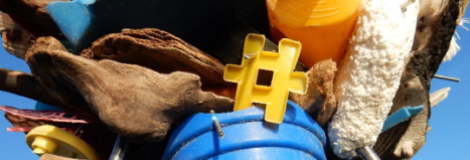This post comes from the Artists and Climate Change Blog
by Guest Blogger Emeric Jacob
The edges of the earth must be explored by bike… I jump on my bicycle fitted with a trailer and head towards the beach of Terre Neuve in Camargue in order to recharge my batteries, read, and unearth creatures hidden in the deposits from the sea.
Like the scattered pieces of a jigsaw puzzle, unending beaches, dunes, meandering canals, and ponds come together in the first light of dawn to reveal the preserved and wild Camargue. With the sun’s first rays, the quietness of the night is disturbed by the mistral wind which whips sand on bare legs and face. Blown by the wind, the crop is ready to be harvested from the wide flat expanse. Plastic rubbish, half buried bottles, and polystyrene fragments entwined with marran grass both occupy and are hidden in that place. The landscape is striking, buried under great waves of sand where the water rushes during storms. Everything the sea has been carrying in its bowels for days seems to be stored there. An eclectic collection of objects weathered by wind and sun: reeds, roots, branches, boat pieces, fence poles, pens, corks, bottles, games, boxes, cans, green-orange-and-black ropes…
Sailing on this sea of sand, I fill bag after bag, weighing down the trailer. It’s time to find a place where I can allow the composition of the objects to emerge and retranscribe the omens they convey.
These fragments are collected from different preserved and wild sites because of their volume, color, texture and aesthetic value. The fragments are then sorted out, washed and classified. Chance, opportunity, and choice determine the contents of this eclectic collection.
Stainless steel rods going straight through the different objects create complex spatial correlations. A new entity is born from the many connections between elements. An ecosystem forms. These organic and non-organic objects are organized in a unique and non-reproducible way for each sculpture, and are different at every site.
The tripod creatures are set up on the site where they have been harvested in the silence of dawn. Waiting beside the sculptures in the  fresh air of the early morning is a surreal experience. The first rays of sun reveal the creatures’ strange shapes. Waves break on the beach and caress their feet. A full family of creatures, all of different sizes, emerges from the quiet morning waters. The scene is immortalized in a picture as a testimony.
______________________________
Passionate about sculpture, nature and travel since my childhood, I have been carving and sculpting whatever I come across. From troglodyte rocks to various materials brought by the sea, I have been inspired by it all. Then at one point, I became eager to understand and make my own “systems†and chose to study at an engineering and research graduate school. I was an engineer for twelve years, funneling my urge to create into the construction sector. Because I have always been a builder with a passion for technique and nature, I naturally gravitated towards working on renewable energy building sites. However, I now choose to express this commitment through artistic creation. Eager to share my concerns about environmental change and travel all over the world, I make my creations come to life thanks to artistic exhibitions and collaboration.
You can find me at www.emericjacob.com and https://www.facebook.com/emericsculptures/.
______________________________
Follow us on Facebook and Twitter.
Filed under: Guest Blog Series, Sculpture
![]()
———-
Artists and Climate Change is a blog that tracks artistic responses from all disciplines to the problem of climate change. It is both a study about what is being done, and a resource for anyone interested in the subject. Art has the power to reframe the conversation about our environmental crisis so it is inclusive, constructive, and conducive to action. Art can, and should, shape our values and behavior so we are better equipped to face the formidable challenge in front of us.
Go to the Artists and Climate Change Blog
Powered by WPeMatico




![Terre Neuve Beach in Camargue [43°28'1.98"N; 4°11'17.83"E]-2016](https://artistsandclimatechange.files.wordpress.com/2016/05/combined-pics.jpg?w=470&h=113&resize=470%2C113)


![Aresquiers Beach [43°29'52.41"N/ 3°52'8.52"E]- 2015.](https://artistsandclimatechange.files.wordpress.com/2016/05/picture4.png?w=470&h=143&resize=470%2C143)
